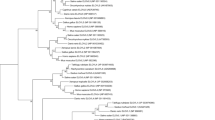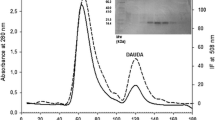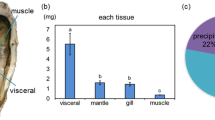Abstract
Pharmaceuticals and their metabolites constitute a class of xenobiotics commonly found in aquatic environments which may cause toxic effects in aquatic organisms. Several different lipophilic molecules, including some pharmaceuticals, can bind to fatty acid-binding proteins (FABPs), a group of evolutionarily related cytoplasmic proteins that belong to the intracellular lipid-binding protein (iLBP) family. An oyster FABP genome-wide investigation was not available until a recent study on gene organization, protein structure, and phylogeny of Crassostrea gigas iLBPs. Higher transcript levels of the C. gigas FABP2 gene were found after exposure to sewage and pharmaceuticals. Because of its relevance as a potential biomarker of aquatic contamination, in this study, recombinant FABP2 from C. gigas (CgFABP2) was successfully cloned, expressed, and purified, and in vitro and in silico assays were performed using lipids and pharmaceuticals. This is the first characterization of a protein from the iLBP family in C. gigas. Homology modeling and molecular docking were used to evaluate the binding affinities of natural ligands (palmitic, oleic, and arachidonic acids) and pharmaceuticals (ibuprofen, sodium diclofenac, and acetaminophen). Among the tested fatty acids, CgFABP2 showed preference for palmitic acid. The selected pharmaceuticals presented a biphasic-binding mode, suggesting a different binding affinity with a preference for diclofenac. Therefore, the approach using circular dichroism and in silico data might be useful for ligand-binding screening in an invertebrate model organism.
Graphical abstract





Similar content being viewed by others
Data availability
Not applicable.
Change history
19 March 2021
A Correction to this paper has been published: https://doi.org/10.1007/s11356-021-13135-x
References
Ascoli G, Bertucci C, Salvadori P (1995) Stereospecific and competitive binding of drugs to human serum albumin: a difference circular dichroism approach. J Pharm Sci 84(6):737–741. https://doi.org/10.1002/jps.2600840615
Bayen S, Lee HK, Obbard JP (2007) Exposure and response of aquacultured oysters, Crassostrea gigas, to marine contaminants. Environ Res 103:375–382. https://doi.org/10.1016/j.envres.2006.06.012
Bilbao E, Raingeard D, de Cerio OD, Ortiz-Zarragoitia M, Ruiz P, Izagirre U, Orbea A, Marigómez I, Cajaraville MP, Cancio I (2010) Effects of exposure to prestige-like heavy fuel oil and to perfluorooctane sulfonate on conventional biomarkers and target gene transcription in the thicklip grey mullet Chelon labrosus. Aquat Toxicol 98(3):282–296. https://doi.org/10.1016/j.aquatox.2010.02.018
Boutet I, Tanguy A, Moraga D (2004) Response of the Pacific oyster Crassostrea gigas to hydrocarbon contamination under experimental conditions. Gene 329:147–157. https://doi.org/10.1016/j.gene.2003.12.027
Bowie JU, Lüthy R, Eisenberg D (1991) A method to identify protein sequences that fold into a known three-dimensional structure. Science 12:253(5016):164-170. https://doi.org/10.1126/science.1853201
Cai H, Yan G, Zhang X, Gorbenko O, Wang H, Zhu W (2010) Discovery of highly selective inhibitors of human fatty acid binding protein 4 (FABP4) by virtual screening. Bioorg Med Chem Lett 20:3675–3679. https://doi.org/10.1016/j.bmcl.2010.04.095
Chuang S, Velkov T, Horne J, Porter CJH, Scanlon MJ (2008) Characterization of the drug binding specificity of rat liver fatty acid binding protein. J Med Chem 51:3755–3764. https://doi.org/10.1021/jm701192w
Cistola DP, Kim K, Rogi H, Frieden C (1996) Fatty acid interactions with a helix-less variant of intestinal fatty acid binding protein. Biochemistry 35(23):7559–7565. https://doi.org/10.1021/bi952912x
David E, Tanguy A, Pichavant K, Moraga D (2005) Response of the Pacific oyster Crassostrea gigas to hypoxia exposure under experimental conditions. FEBS J 272:5635–5652. https://doi.org/10.1111/j.1742-4658.2005.04960.x
Dussault EB, Balakrishnan VK, Sverko E, Solomon KR, Sibley PK (2008) Toxicity of human pharmaceuticals and personal care products to benthic invertebrates. Environ Toxicol Chem 27(2):425–432. https://doi.org/10.1897/07-354R.1
Esteves A, Ehrlich R (2006) Invertebrate intracellular fatty acid binding proteins. Comp Biochem Phys C 142(3–4):262–274. https://doi.org/10.1016/j.cbpc.2005.11.006
Fiser A (2010) Template-based protein structure modeling. Method Mol Biol 673:73–94. https://doi.org/10.1007/978-1-60761-842-3_6
Flores-Nunes F, Mattos JJ, Zacchi FL, Serrano MAS, Piazza CE, Sasaki ST, Taniguchi S, Bícego MC, Melo CMR, Bainy ACD (2015) Effect of linear alkylbenzene mixtures and sanitary sewage in biochemical and molecular responses in Pacific oyster Crassostrea gigas. Environ Sci Pollut Res 22(22):17386–17396. https://doi.org/10.1007/s11356-015-4486-7
Furuhashi M, Hotamisligil GS (2008) Fatty acid-binding proteins: role in metabolic diseases and potential as drug targets. Nat Rev Drug Discov 7(6):489–503. https://doi.org/10.1038/nrd2589
Gagné F, Blaise C, Andre C (2006) Occurrence of pharmaceutical products in a municipal effluent and toxicity to rainbow trout (Oncorhynchus mykiss) hepatocytes. Ecotox Environ Safe 64:329–336. https://doi.org/10.1016/j.ecoenv.2005.04.004
Gasteiger E, Hoogland C, Gattiker A, Duvaud S, Wilkins MR, Appel RD, Bairoch A (2005) Protein identification and analysis tools on the ExPASy server. In: John M Walker (ed) the proteomics protocols handbook. Human Press, pp 571-607
González JM, Fischer SZ (2015) Structural analysis of ibuprofen binding to human adipocyte fatty acid binding protein (FABP4). Acta Cryst 71:163–170. https://doi.org/10.1107/S2053230X14027897
Gonzalez-Rey M, Bebianno MJ (2014) Effects of non-steroidal anti-inflammatory drug (NSAID) diclofenac exposure in mussel Mytilus galloprovincialis. Aquat Toxicol 148:221–230. https://doi.org/10.1016/j.aquatox.2014.01.011
Greenfield NJ (2006) Using circular dichroism spectra to estimate protein secondary structure. Nat Protoc 1:2876–2890. https://doi.org/10.1038/nprot.2006.202
Grosdidier A, Zoete V, Michielin O (2011) SwissDock, a protein-small molecule docking web service based on EADock DSS. Nucleic Acids Res 39:W270–W277. https://doi.org/10.1093/nar/gkr366
Hernando MD, Mezcua M, Fernandéz-Alba AR, Barceló D (2006) Environmental risk assessment of pharmaceutical residues in wastewater effluents, surface waters, and sediments. Talanta 69:334–342. https://doi.org/10.1016/j.talanta.2005.09.037
Hertzel AV, Hellberg K, Reynolds JM, Kruse AC, Juhlmann BE, Smith AJ, Sanders MA, Ohlendorf DH, Suttles J, Bernlohr DA (2009) Identification and characterization of a small molecule inhibitor of fatty acid binding proteins. J Med Chem 52:6024–6031. https://doi.org/10.1021/jm900720m
Hodsdon ME, Cistola DP (1997) Ligand binding alters the backbone mobility of intestinal fatty acid-binding protein as monitored by 15N NMR relaxation and 1H exchange. Biochemistry 36:2278–2290. https://doi.org/10.1021/bi962018l
Huggett DB, Cook JC, Ericson JF, Williams RT (2003) A theoretical model for utilizing mammalian pharmacology and safety data to prioritize potential impacts of human pharmaceuticals to fish. Hum Ecol Risk Assess 9:1789–1799. https://doi.org/10.1080/714044797
Hunter NH, Bakula BC, Bruce CD (2017) Molecular dynamics simulations of apo and holo forms of fatty acid binding protein 5 and cellular retinoic acid binding protein II reveal highly mobile protein, retinoic acid ligand, and water molecules. J Biomol Struct Dyn 36(7):1893–1907. https://doi.org/10.1080/07391102.2017.1337591
Huvet A, Herpin A, Dégremontc L, Labreuchea Y, Samaina JF, Cunningham C (2004) The identification of genes from the oyster Crassostrea gigas that are differentially expressed in progeny exhibiting opposed susceptibility to summer mortality. Gene 343(1):1–29. https://doi.org/10.1016/j.gene.2004.09.008
Jones OA, Lester LN, Voulvoulis N (2005) Pharmaceuticals: a threat to drinking water? Trends Biotechnol 23:163–167. https://doi.org/10.1016/j.tibtech.2005.02.001
Kim Y, Choi K, Jung J, Park S, Kim PG, Park J (2007) Aquatic toxicity of acetaminophen, carbamazepine, cimetidine, diltiazem, and six major sulfonamides, and their potential ecological risks in Korea. Environ Int 33:370–375. https://doi.org/10.1016/j.envint.2006.11.017
Kolpin DW, Furlong ET, Meyer MY, Thurman EM, Zaugg SD, Barber LB, Buxton HT (2002) Pharmaceuticals, hormones, and other organic wastewater contaminants in U.S. streams, 1999-2000: a national reconnaissance. Environ Sci Technol 36:1202–1211. https://doi.org/10.1021/es011055j
LaLonde JM, Bernlohr DA, Banaszak LJ (1994) The up-and-down beta-barrel proteins. The FASEB J 8(15):1240–1247. https://doi.org/10.1096/fasebj.8.15.8001736
Lang RP, Bayne CJ, Camara MD, Cunningham C, Jenny MJ, Langdon CJ (2009) Transcriptome profiling of selectively bred Pacific oyster Crassostrea gigas families that differ in tolerance of heat shock. Mar Biotechnol 11:650–668. https://doi.org/10.1007/s10126-009-9181-6
Langford KH, Thomas KV (2009) Determination of pharmaceutical compounds in hospital effluents and their contribution to wastewater treatment works. Environ Int 35:766–770. https://doi.org/10.1016/j.envint.2009.02.007
Laskowski RA, MacArthur MW, Moss DS, Thornton JM (1993) PROCHECK: a program to check the stereochemical quality of protein structures. J Appl Crystallogr 26:283–291. https://doi.org/10.1107/S0021889892009944
Liu Y, Wang J, Wei Y, Zhang H, Xu M, Dai J (2008) Induction of time-dependent oxidative stress and related transcriptional effects of perfluorododecanoic acid in zebrafish liver. Aquat Toxicol 89(4):242–250. https://doi.org/10.1016/j.aquatox.2008.07.009
Lolić A, Paíga P, Santos LHMLM, Ramos S, Correia M, Delerue-Matos C (2015) Assessment of non-steroidal anti-inflammatory and analgesic pharmaceuticals in seawaters of north of Portugal: occurrence and environmental risk. Sci Total Environ 508:240–250. https://doi.org/10.1016/j.scitotenv.2014.11.097
Medeiros I, Siebert MN, Toledo-Silva G, Moraes MO, Marques MRF, Bainy ACD (2008) Differential gene expression in oyster exposed to sewage. Mar Environ Res 66:156–157. https://doi.org/10.1016/j.marenvres.2008.02.048
Martin GG, McIntosh AL, Huangt H, Gupta S, Asthaves B, Landrock KK, Landrock D, Kier AB, Schroeder F (2013) The human liver fatty acid binding protein T94A variant alters the structure, stability and interaction with fibrates. Biochem. 52:9347–9357. https://doi.org/10.1021/bi401014k
Mello DF, Oliveira ES, Vieira RC, Simoes E, Trevisan R, Dafre AL, Barracco MA (2012) Cellular and transcriptional responses of Crassostrea gigas hemocytes exposed in vitro to brevetoxin (PbTx-2). Mar Drugs 10:583–597. https://doi.org/10.3390/md10030583
Mezzelani M, Gorbi S, Fattorini D, d’ Errico G, Consolandi G, Milan M, Bargelloni L, Regoli F (2018) Long-term exposure of Mytilus galloprovincialis to diclofenac, ibuprofen and ketoprofen: insights into bioavailability, biomarkers and transcriptomic changes. Chemosphere, 198:238–248. https://doi.org/10.1016/j.chemosphere.2018.01.148
Milles AJ, Wallace BA (2006) Synchrotron radiation circular dichroism spectroscopy of proteins and applications in structural and functional genomics. Chem Soc Rev 35:39–51. https://doi.org/10.1039/B316168B
Nikolaou A, Meric S, Fatta D (2007) Occurrence patterns of pharmaceuticals in water and wastewater environments. Anal Bioanal Chem 387:1225–1234. https://doi.org/10.1007/s00216-006-1035-8
Olivares-Rubio HF, Vega-López A (2016) Fatty acid metabolism in fish species as a biomarker for environmental monitoring. Environ Pollut 218:297–312. https://doi.org/10.1016/j.envpol.2016.07.005
Pruden A, Larsson DGJ, Amézquita A, Collignon P, Brandt KK, Graham DW, Lazorchak JM, Suzuki S, Silley P, Snape JR, Topp E, Zhang T, Zhu YG (2013) Management options for reducing the release of antibiotics and antibiotic resistance genes to the environment. Environ Health Persp 121(8):878–885. https://doi.org/10.1289/ehp.1206446
Rivera-Utrilla J, Sánchez-Polo M, Ferro-García MA, Prados-Joya G, Ocampo-Pérez R (2013) Pharmaceuticals as emerging contaminants and their removal from water. A review Chemosphere 93(7):1268–1287. https://doi.org/10.1016/j.chemosphere.2013.07.059
Roche O, Kiyama R, Brooks CL (2001) Ligand-protein database: linking protein-ligand complex structures to binding data. J Med Chem 44:3592–3598. https://doi.org/10.1021/jm000467k
Saavedra C, Bachère E (2006) Bivalve genomics. Aquaculture 256:1–14. https://doi.org/10.1016/j.aquaculture.2006.02.023
Sacchettini JC, Gordon JI, Banaszak LJ (1989) Crystal structure of rat intestinal fatty-acid-binding protein: refinement and analysis of the Escherichia coli-derived protein with bound palmitate. J Mol Biol 208:327–339. https://doi.org/10.1016/0022-2836(89)90392-6
Sirés I, Brillas E (2012) Remediation of water pollution caused by pharmaceutical residues based on electrochemical separation and degradation technologies: a review. Environ Int 40:212- 229. https://doi.org/10.1016/j.envint.2011.07.012
Serrano MAS, Gonzalez-Rey M, Mattos JJ, Flores-Nunes F, Mello ACP, Zacchi FL, Piazza CE, Siebert MN, Piazza RS, Alvarez-Muñoz D, Rodriguez-Mozaz S, Barceló D, Bebianno MJ, Gomes CHAM, Melo CMR, Bainy ACD (2015) Differential gene transcription, biochemical responses, and cytotoxicity assessment in Pacific oyster Crassostrea gigas exposed to ibuprofen. Environ Sci Pollut Res 22:17375–11785. https://doi.org/10.1007/s11356-014-4023-0
Smathers RL, Petersen DR (2011) The human fatty acid-binding protein family: evolutionary divergences and functions. Hum Genomics 5(3):170–191. https://doi.org/10.1186/1479-7364-5-3-170
Thomaidis NS, Asimakopoulos AG, Bletsou AA (2012) Emerging contaminants: a tutorial mini-review. Global NEST J 14(1):72-79. https://doi.org/10.30955/gnj.000823
Toledo-Silva G, Razzera G, Zacchi FL, Wendt NC, Mattos JJ, Bainy ACD (2017) Intracellular lipid binding protein family diversity from oyster Crassostrea gigas: genomic and structural features of invertebrate lipid transporters. Sci Rep 7:46486. https://doi.org/10.1038/srep46486
Trombini C, Hampel M, Blasco J (2019) Assessing the effect of human pharmaceuticals (carbamazepine, diclofenac and ibuprofen) on the marine clam Ruditapes philippinarum: an integrative and multibiomarker approach. Aquat Toxicol 208:146–156. https://doi.org/10.1016/j.aquatox.2019.01.004
Velkov T, Chuang S, Wielens J, Sakellaris H, Charman WN, Porter CJH, Scanlon MJ (2005) The interaction of lipophilic drugs with intestinal fatty acid-binding protein. J Biol Chem 280:17769–17776. https://doi.org/10.1074/jbc.M410193200
Velkov T (2013) Interactions between human liver fatty acid binding protein and peroxisome proliferator activated receptor selective drugs. PPAR Res 2013:1–15. https://doi.org/10.1155/2013/938401
Waterhouse A, Bertoni M, Bienert S, Studer G, Tauriello G, Gumienny R, Heer FT, de Beer TAP, Rempfer C, Bordoli L, Lepore R, Schwede T (2018) SWISS-MODEL: homology modelling of protein structures and complexes. Nucleic Acids Res 46(W1):W296–W303. https://doi.org/10.1093/nar/gky427
Wei Y, Thyparambil AA, Latour RA (2014) Protein helical structure determination using CD spectroscopy for solutions with strong background absorbance from 190 to 230nm. Biochim Biophys Acta 1844(12):2331–2337. https://doi.org/10.1016/j.bbapap.2014.10.001
Wiedemann C, Bellstedt P, Görlach M (2013) CAPITO—a web server-based analysis and plotting tool for circular dichroism data. Bioinformatics 29(14):1750–1757. https://doi.org/10.1093/bioinformatics/btt278
Wiederstein M, Sippl MJ (2007) ProSA-web: interactive web service for the recognition of errors in three-dimensional structures of proteins. Nucleic Acids Res 35:W407–W410. https://doi.org/10.1093/nar/gkm290
Yuan F, Hu C, Hu X, Qu J, Yang M (2009) Degradation of selected pharmaceuticals in aqueous solution with UV and UV/H2O2. Water Res 43:1776–1774. https://doi.org/10.1016/j.watres.2009.01.008
Zacchi FL, Flores-Nunes F, Mattos JJ, Lima D, Lüchmann KH, Sasaki ST, Bícego MC, Taniguchi S, Montone RC, de Almeida EA, Bainy ACD (2018) Biochemical and molecular responses in oysters Crassostrea brasiliana collected from estuarine aquaculture areas in southern Brazil. Mar Pollut Bull 135:110–118. https://doi.org/10.1016/j.marpolbul.2018.07.018
Zeng X, Ye H, Yang Y, Wang G, Huang H (2013) Molecular cloning and functional analysis of the fatty acid-binding protein (Sp-FABP) gene in the mud crab (Scylla paramamosain). Genet Mol Biol 36:140–147. https://doi.org/10.1590/S1415-47572013005000007
Zhang G, Fang X, Guo X, Li L, Luo R, Xu F, Yang P, Zhang L, Wang X, Qi H, Xiong Z, Que H, Xie Y, Holland PWH, Paps J, Zhu Y, Wu F, Chen Y, Wang J, Peng C, Meng J, Yang L, Liu J, Wen B, Zhang N, Huang Z, Zhu Q, Feng Y, Mount A, Hedgecock D, Xu Z, Liu Y, Domazet-Lošo T, du Y, Sun X, Zhang S, Liu B, Cheng P, Jiang X, Li J, Fan D, Wang W, Fu W, Wang T, Wang B, Zhang J, Peng Z, Li Y, Li N, Wang J, Chen M, He Y, Tan F, Song X, Zheng Q, Huang R, Yang H, du X, Chen L, Yang M, Gaffney PM, Wang S, Luo L, She Z, Ming Y, Huang W, Zhang S, Huang B, Zhang Y, Qu T, Ni P, Miao G, Wang J, Wang Q, Steinberg CEW, Wang H, Li N, Qian L, Zhang G, Li Y, Yang H, Liu X, Wang J, Yin Y, Wang J (2012) The oyster genome reveals stress adaptation and complexity of shell formation. Nature. 490:49–54. https://doi.org/10.1038/nature11413
Zhang L, Ren X, Guo L (2013) Structure-based investigation on the interaction of perfluorinated compounds with human liver fatty acid binding protein. Environ Sci Technol 47:11293–11301. https://doi.org/10.1021/es4026722
Zhang G, Li L, Meng J, Qi H, Qu T, Xu F, Zhan L (2016) Molecular basis for adaptation of oysters to stressful marine intertidal environments. Annu Rev Ani Biosci 4:357–381. https://doi.org/10.1146/annurev-animal-022114-110903
Zheng Y, Blair D, Bradley JE (2013) Phyletic distribution of fatty acid binding protein genes. PLoS One 8:1–9. https://doi.org/10.1371/journal.pone.0077636
Zsila F (2013) Circular dichroism spectroscopic detection of ligand binding induced subdomain IB specific structural adjustment of human serum albumin. J Phys Chem B 117(37):10798–10806. https://doi.org/10.1021/jp4067108
Acknowledgements
The authors would like to thank the Laboratório Central de Biologia Molecular Estrutural (CEBIME/UFSC) for use in their structural biology facilities.
Funding
This research was funded by the Conselho Nacional de Desenvolvimento Científico e Tecnológico (CNPq Grant # 406104/2013-1 – PVE Fellowship). Juliana F. Tisca, MSc. and Tomás B. Pessatti, MSc. are PhD fellows at the Coordenação de Aperfeiçoamento de Pessoal de Nível Superior (CAPES). Fabiola S. Soares and Karin dos Santos were fellows at the CNPq. Dr. Flávia L. Zacchi is a postdoctoral fellow at the Coordenação de Aperfeiçoamento de Pessoal de Nível Superior (CAPES). Dr. Afonso Celso Dias Bainy is a recipient of the CNPq productivity fellowship. M. J. Bebianno is a recipient of the CNPq PVE fellowship and also acknowledges the support of the Portuguese Science Foundation (FCT) through the grant UID/MAR/00350/2013 attributed to CIMA, at the University of Algarve.
Author information
Authors and Affiliations
Contributions
JFT conducted the experiments, analyzed the data, and wrote the manuscript. TBP performed the experiment and analyzed the data. FSS performed the experiment. KdS performed the in silico experiments, analyzed the data and helped with writing the manuscript. VAO performed the circular dichroism and analyzed the data. FLZ, MJAFB, ACDB, and GR analyzed the data, and contributed in the discussions, writing process, and proofreading of the manuscript. All authors read and approved the final version of the manuscript.
Corresponding authors
Ethics declarations
Ethics approval and consent to participate
Not applicable.
Consent for publication
Not applicable.
Competing interests
The authors declare no competing interests.
Additional information
Editorial Responsibility: Ta Yeong Wu
Publisher’s note
Springer Nature remains neutral with regard to jurisdictional claims in published maps and institutional affiliations.
The original online version of this article was revised: The correct Figure 3 is presented in this paper.
Supplementary information
ESM 1
(PDF 1344 kb)
Rights and permissions
About this article
Cite this article
Tisca, J.F., dos Santos, K., Pessati, T.B. et al. Characterization of a fatty acid-binding protein from the Pacific oyster (Crassostrea gigas): pharmaceutical and toxicological implications. Environ Sci Pollut Res 28, 27811–27822 (2021). https://doi.org/10.1007/s11356-021-12645-y
Received:
Accepted:
Published:
Issue Date:
DOI: https://doi.org/10.1007/s11356-021-12645-y




